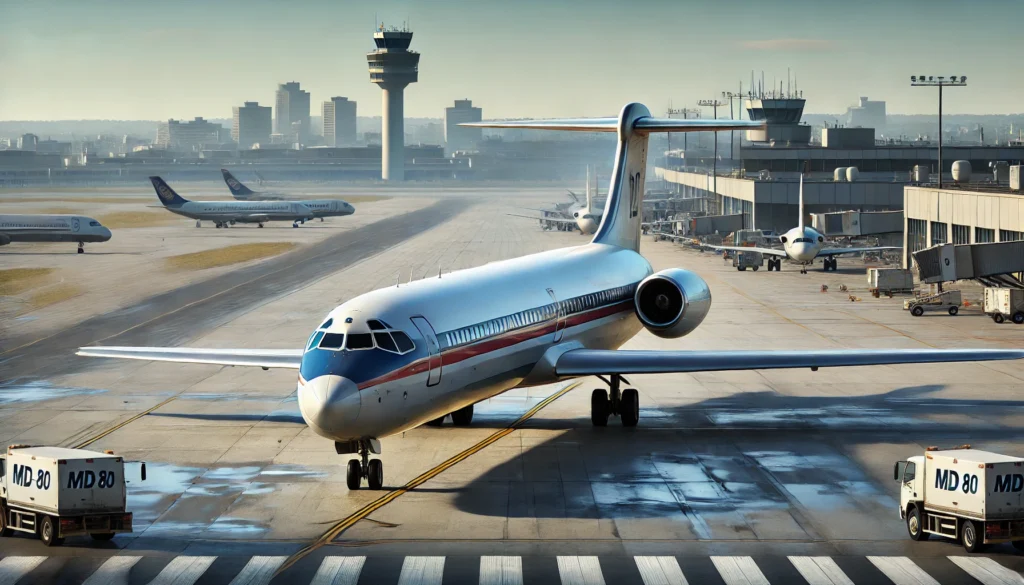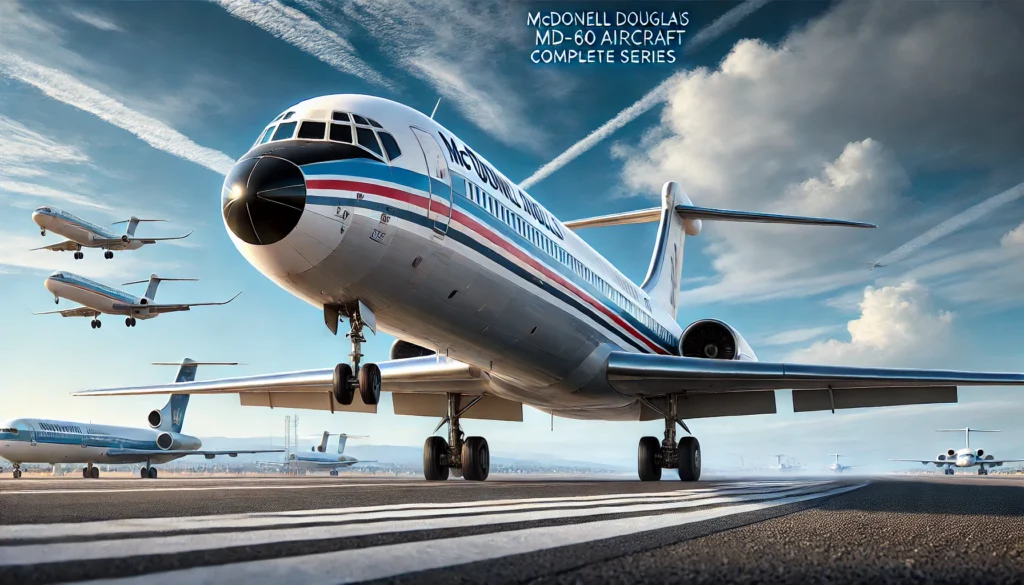Welcome to Wings Over Cloud, where we dive deep into the world of aviation. Today, I’m excited to explore the McDonnell Douglas MD 80 series, a significant player in commercial aviation history. We’ll cover everything you need to know about this aircraft family, from its development to its operational history.
Introduction of the McDonnell Douglas MD 80 Series

The McDonnell Douglas MD-80 series, introduced in the 1980s, represents an evolution of the DC-9 family. This aircraft series quickly became a favorite for airlines due to its reliability, efficiency, and passenger comfort. Let’s delve into the specifics of each model within the series.
Development and Design Of McDonnell Douglas MD 80 Series
The MD-80 series began as an upgrade to the DC-9, featuring advanced avionics, improved engines, and a stretched fuselage. This development aimed to offer airlines more fuel-efficient and higher-capacity aircraft.
Key Features Of McDonnell Douglas MD 80 Series
- Engines: Equipped with JT8D-200 series engines, providing better performance and lower fuel consumption.
- Fuselage: Stretched fuselage allowed for more seating capacity.
- Avionics: Updated avionics systems for improved navigation and safety.
- Wing Design: Enhanced wing design for better aerodynamics.
MD-81: The First in the Series
The MD-81, the first model, was introduced in 1980. It offered seating for up to 172 passengers, making it suitable for short to medium-haul flights. Airlines appreciated its efficiency and reliability.
McDonnell Douglas MD 80 Series Operational History

Many airlines, including American Airlines and SAS, adopted the MD-81. Its range and payload capabilities made it versatile, operating on various routes.
MD-82: Enhanced Performance
The MD-82 followed, featuring more powerful engines and improved performance. It became popular for routes requiring higher payloads.
Technical Specifications
- Engines: JT8D-217 engines, offer increased thrust.
- Seating Capacity: Up to 172 passengers.
- Range: Approximately 2,050 nautical miles.
MD-83: Extended Range
The MD-83 introduced an extended range, making it suitable for longer routes. This model featured additional fuel capacity, allowing airlines to expand their route networks.
Unique Attributes
- Extended Range: Increased to approximately 2,504 nautical miles.
- Fuel Efficiency: Improved fuel management systems.
- Passenger Comfort: Enhanced interior for better passenger experience.
MD-87: A Shorter Variant
The MD-87 was designed as a shorter variant with a reduced seating capacity. This model was ideal for routes with lower passenger demand.
Design Adjustments
- Fuselage: Shortened by 17 feet.
- Seating Capacity: Up to 130 passengers.
- Range: Approximately 2,370 nautical miles.
MD-88: The Final Model
The MD-88, introduced in the late 1980s, featured the most advanced avionics and passenger amenities. It became a staple for many airlines due to its modern features.
Technological Advancements
- Glass Cockpit: State-of-the-art avionics systems.
- Passenger Experience: Improved seating and cabin layout.
- Efficiency: Enhanced fuel efficiency and range.
The MD-80 Series in Operation
The MD-80 series saw widespread use across the globe. Its versatility made it suitable for various airlines, from major carriers to smaller regional operators.
Major Operators
- American Airlines: One of the largest operators, with a fleet of over 300 MD-80s at its peak.
- Delta Air Lines: Utilized the MD-88 extensively.
- Allegiant Air: Operated MD-80s on leisure routes.
The Legacy of the McDonnell Douglas MD 80 Series

The MD-80 series left a lasting legacy in aviation. Its influence extended beyond commercial aviation, with some models adapted for cargo and military use.
Impact on Aviation
- Reliability: Known for its robust design and reliability.
- Versatility: Adaptable to various routes and operations.
- Efficiency: Set a standard for fuel-efficient aircraft design.
FAQs About the McDonnell Douglas MD 80 Series
Q: What are the key differences between the MD-80 models?
A: The main differences lie in engine performance, range, and seating capacity. For instance, the MD-83 has a longer range than the MD-81, while the MD-87 has a shorter fuselage.
Q: Why was the MD-80 series so popular with airlines?
A: Its popularity stemmed from its reliability, efficiency, and versatility. Airlines found it cost-effective for both short and medium-haul flights.
Q: Are any MD-80s still in operation today?
A: While many have retired, some airlines and charter companies still operate MD-80s due to their durability and performance.
Q: How does the MD-80 series compare to modern aircraft?
A: While newer aircraft offer better fuel efficiency and advanced technology, the MD-80 series remains competitive in terms of reliability and operational cost.
Q: What was the passenger experience like on the MD-80 series?
A: Passengers enjoyed a comfortable cabin, with spacious seating and a smooth ride, contributing to its popularity.
Final Thoughts: The Enduring Appeal of the McDonnell Douglas MD 80 Series
The McDonnell Douglas MD-80 series has earned its place in aviation history. Its development marked a significant step forward in aircraft design, offering airlines a reliable and efficient option. As we reflect on its legacy, it’s clear that the MD-80 series remains a beloved part of the aviation community.
In conclusion, the MD-80 series exemplifies the innovation and progress in aviation technology. Its impact continues to be felt, and its legacy will be remembered for years to come. Whether you’re an aviation enthusiast or a professional in the field, the story of the MD-80 series is both fascinating and inspiring.
For more insights and articles about aviation, check out Wings Over Cloud. We cover everything from aircraft history to the latest industry trends. Stay tuned for more in-depth articles, and feel free to explore our extensive library of aviation content.

